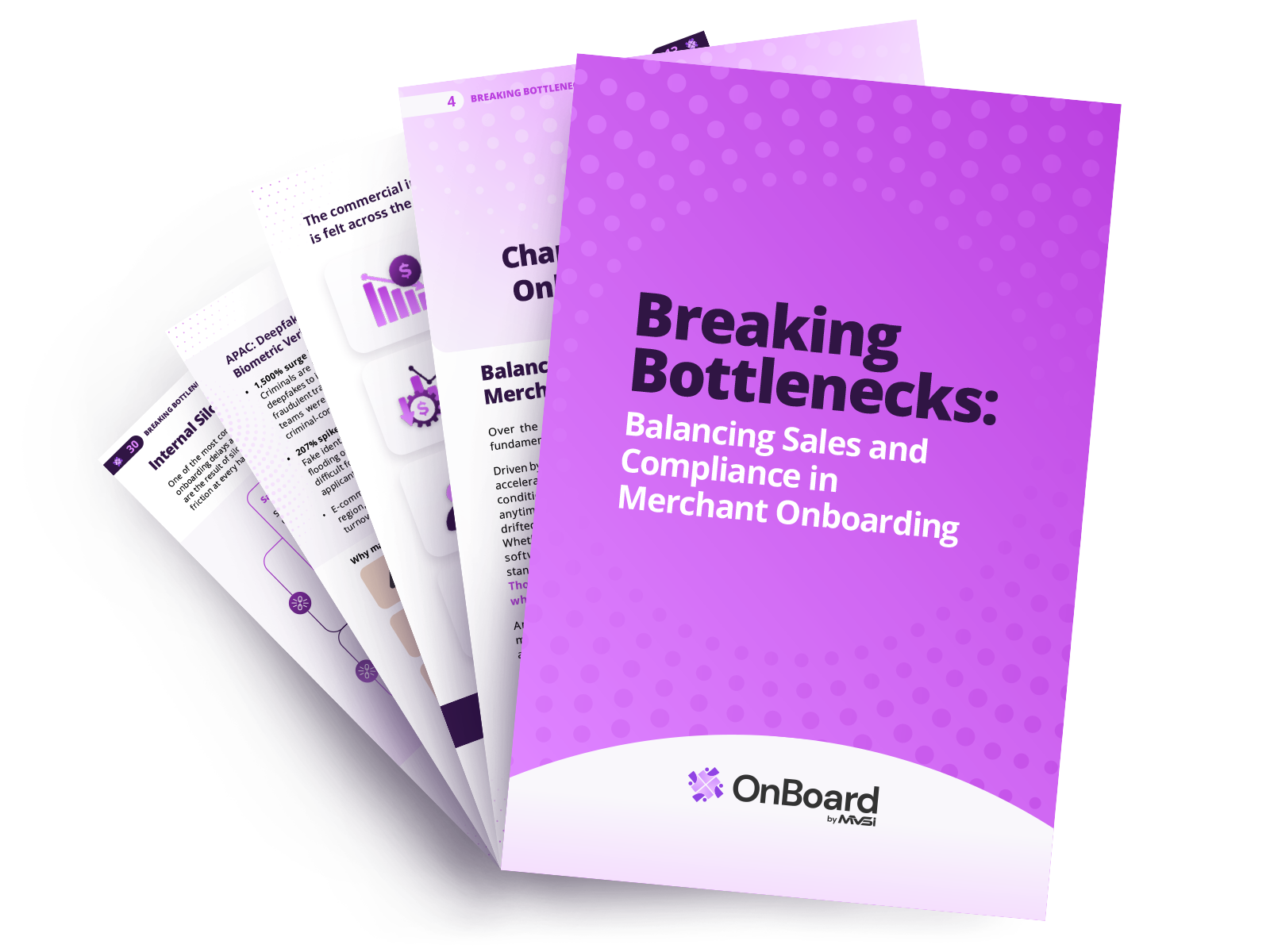If you work in compliance for a payment service provider, ISO, or non-bank lender, you already know the frustration. Every merchant onboarding cycle feels like déjà vu. Endless document collection. Spreadsheets full of status updates. Verification requests bouncing between departments.
You need to protect your organization and meet every regulatory requirement, but right now it feels like compliance is working against your ability to move fast. Each new merchant means more manual steps, more handoffs, and more waiting.
And while many teams think they just need a better KYC tool, the problem goes deeper. The issue isn’t one broken step. It’s the way the entire merchant onboarding process is fragmented.
Key Takeaways
- Fragmented merchant onboarding is the real problem: KYC, KYB, and AML verifications are often handled in isolation across multiple tools, creating manual work, rekeying, and slow approvals that frustrate teams and merchants alike.
- KYC is a lifecycle, not a one-time event: Effective compliance requires ongoing monitoring and layered, risk-based controls, not just document checks at onboarding.
- KYB is just as critical as KYC: Verifying business ownership, structure, and UBOs is essential for merchant onboarding, especially for ISOs and PayFac models managing downstream risk.
- Digital onboarding boosts both compliance and conversion: Automation, biometric verification, and real-time checks simplify the merchant experience while improving accuracy and reducing false positives.
- End-to-end automation is the future: A unified onboarding platform that integrates data capture, document verification, KYC, KYB, AML, and risk decisioning delivers faster activation, lower costs, and stronger compliance outcomes.
The Real Issue: Fragmentation
Every department owns a small part of onboarding. Sales captures information. Credit checks financials. Risk assesses exposure. Compliance verifies identities. Legal handles contracts.
Each team uses its own tool for its part of the job. One system for digital forms. Another for document verification. Another for sanctions checks. Another for contract generation. None of them talk to each other.
This disconnection means teams have little to no visibility into the progress of other departments. Sales may not know when compliance has completed verification. Risk may be unaware of delays in credit checks. Without a shared view, collaboration breaks down, and communication turns reactive instead of proactive.
The result is duplication, rekeying, missed updates, and conflicting data. The merchant feels the friction, your team feels the pressure, and valuable time is lost.
It is also important to remember that KYC is a component of AML, not a synonym. Document checks alone are not enough to manage risk. A layered, risk-based approach is required to verify customers, detect suspicious activity, and maintain compliance across jurisdictions.
And KYC is a lifecycle, not an event. Verification at onboarding alone is not enough to stay fraud free. Organizations need ongoing monitoring and controls beyond day one to identify changing risk profiles and maintain continuous compliance.
Even the best KYC solution cannot fix a process that is broken from start to finish. When critical onboarding steps such as data collection, document upload, KYC, KYB, AML, risk assessment, and contract management are handled in isolation, compliance remains slow, manual, and reactive.
The Hidden Cost of Manual Compliance
Manual onboarding isn’t just inefficient. It is expensive.
As AML regulations expand and ultimate beneficial ownership (UBO) transparency becomes a global priority, compliance workloads keep growing. Yet many teams are still relying on spreadsheets and email chains to track progress.
The direct costs are obvious, but the hidden costs are even more damaging:
- Slower time to revenue: Every delay in onboarding means delayed activation and missed income.
- Higher operational costs: Repeated verification steps waste time and resources.
- Increased risk exposure: Fragmented records make it harder to demonstrate full compliance and audit readability.
- Employee burnout: Skilled analysts are stuck performing repetitive, low-value work instead of focusing on genuine risk management.
Manual onboarding might seem manageable today, but at scale, it holds back growth and puts compliance teams under constant stress.
Why Patching KYC and KYB isn’t Enough Anymore
Many organizations try to solve their compliance pain by adding new tools. A better ID checker. A smarter document scanner. A new sanctions API.
Each tool might fix one pain point, but together they add more integration work, more vendor management, and more complexity. Instead of solving the problem, you end up managing a patchwork of disconnected systems.
You can’t automate a broken process. To make KYC, KYB, and AML verifications efficient and reliable, you have to fix onboarding itself.
And that means addressing both sides of the compliance equation — the person and the business.
For merchant onboarding, it’s not enough to verify the signatory. You also need to verify the business behind them. KYB requires validating registration data and corporate structures, identifying ultimate beneficial owners (UBOs), and screening them appropriately.
Modern compliance now defines KYB as establishing the structure, ownership, and economics of a business. Automation and continuous monitoring are now essential to verify company data, cross-check ownership, and manage downstream partner oversight.
This level of rigor is especially important for ISOs and PayFac models, where business partners effectively operate under your brand. When KYB and KYC work together, you gain a complete view of who you are onboarding and the risk they represent.
The Smarter Solution: End-to-End Merchant Onboarding
End-to-end merchant onboarding brings every step together in one connected platform. From data collection to risk decisioning, every process works in sync rather than in silos. The result is faster activation, stronger compliance, and a dramatically improved experience for both teams and merchants.
Why digital onboarding changes everything
Modern onboarding replaces paper and email with digital journeys that support remote submission, automated checks, and instant feedback. This shift improves both compliance and conversion.
Biometric authentication, real-time status updates, and self-service flows make it easier for merchants to complete onboarding while reducing human error. Automation does not mean lowering the bar. It strengthens it. Sanctions and PEP screening, device intelligence, and behavioral analysis all work together to enhance fraud detection and accuracy while reducing false positives.
New AI-driven capabilities now analyse submitted data, verify documents and flag risk in real time, enabling what MVSI describes as a ‘no-human-touch’ onboarding model through OnBoard's AIQtm.
What Best-Practice Onboarding Looks Like
End-to-end merchant onboarding connects every step in a single, intelligent platform. It eliminates silos, automates repetitive tasks, and provides full visibility across KYC, KYB, AML, and risk processes. Here’s what that looks like in practice.
Unified data and workflow
Everyone works from the same set of data and documents. There are no duplicate entries, missing updates, or mismatched records. Each department sees a single version of the truth with full visibility into every stage of onboarding.
OnBoard by MVSI makes this possible by unifying all onboarding activities in one system. It connects seamlessly with existing CRMs, financial systems, and risk tools, so data flows automatically and stays accurate throughout the entire onboarding journey.
Automated KYC, KYB, and AML
Identity verification, sanctions screening, and ownership checks happen automatically. Real-time integrations with trusted global data sources ensure every application is verified consistently and at speed.
OnBoard by MVSI enhances this further with real-time screening, UBO verification, and partner oversight across channels and geographies. The platform’s integrated KYC, KYB, and AML functionality reduces manual work while maintaining complete regulatory coverage. Advanced decision-engine logic now integrates AI models that act, and not just analyse, so that underwriting, KYC/KYB and AML decisions can be made with minimal manual intervention.
Intelligent risk management
A configurable decision engine scores applications in real time as merchants enter their details and routes only exceptions for manual review. This reduces manual effort by up to 80 percent while keeping oversight in the right hands.
OnBoard by MVSI applies a management-by-exception model that automates most routine decisions while flagging higher-risk cases for analyst review. This keeps compliance teams focused on value-added work and ensures every decision is traceable.
Digital onboarding experience
Merchants complete white-labelled online forms, upload documents, verify identities, and sign contracts in a single, seamless flow. The forms are intuitive and dynamically adapt in real time to the information entered by merchants, providing clear prompts and supportive guidance that reduce confusion and prevent fatigue. The experience feels simple, fast, and professional.
With OnBoard by MVSI, digital onboarding is fully configurable. Organizations can offer biometric options, document verification, and self-service journeys that reduce back-and-forth while maintaining strict compliance standards.
Continuous monitoring and audit-ready reporting
Once merchants are approved, automated due diligence and ongoing monitoring continue in the background. Compliance teams stay alert to changes in ownership, risk status, or regulations without rebuilding workflows.
OnBoard by MVSI supports unified audit trails and portfolio controls to simplify reviews and ongoing due diligence. Regular regulatory roundups across the EU, US, and UK help teams stay informed about evolving standards and integrate updates directly into workflows.
The Results of Automation
When every stage of onboarding operates in one seamless system, compliance shifts from being a reactive process to a strategic function. With true AI-driven automation now embedded in the process, compliance teams can go from manual gate-keeping to strategic risk orchestration. Teams no longer spend their days chasing documents or managing disconnected tools. Instead, they can focus on higher-value analysis, proactive risk management, and continuous improvement. That’s where automation begins to deliver measurable business impact.
Compliance teams that adopt automation see immediate, measurable results:
- Faster time to revenue as approval times drop from weeks to days.
- Lower compliance costs by removing duplicate tasks and manual reviews.
- Stronger audit readiness with real-time reporting and complete digital records.
- Happier teams and merchants because onboarding finally feels effortless.
Automation transforms compliance from a blocker into a strategic advantage, empowering teams to manage more risk, more accurately, in less time.
From Fragmented to Unified: The Future of Merchant Onboarding
KYC, KYB, and AML are vital to protecting your business and maintaining trust, but they should never come at the expense of speed or scalability. Compliance should enable growth, not slow it down.
The truth is that KYC, KYB, and AML are not isolated tasks to be handled with separate tools. They are interconnected stages within one continuous merchant onboarding journey that also includes data capture, document verification, intelligent risk management, and ongoing due diligence. The fastest path to compliant growth is to bring all these steps together in a single, unified process.
OnBoard by MVSI was built specifically to solve this challenge. It unifies KYC, KYB, AML, and risk management within one automated platform designed for regulated financial services. It gives organizations full control and visibility while eliminating the slow, manual work that drains productivity.
By consolidating every stage of onboarding — from data collection and document capture to automated verification, decisioning, and ongoing monitoring — OnBoard by MVSI helps compliance teams remove friction, reduce costs, and keep pace with evolving regulations. The recent launch of OnBoard AIQtm marks a key milestone, embedding real-world AI into the platform so decisions are not just faster but smarter and more consistent across risk, KYC, KYB and AML workflows It streamlines the entire merchant journey, empowering teams to work faster without compromising compliance.
Rather than patching together another set of point solutions, look at the bigger picture. True efficiency and accuracy come from end-to-end automation: a merchant onboarding platform that connects every step, from initial application to approval and continuous monitoring, in one seamless experience.
When you unify KYC, KYB, AML, data capture, and risk management, you transform compliance from a reactive necessity into a strategic advantage.
Stop piecing together onboarding point solutions. Automate KYC, AML, and risk in one platform.



.png)



